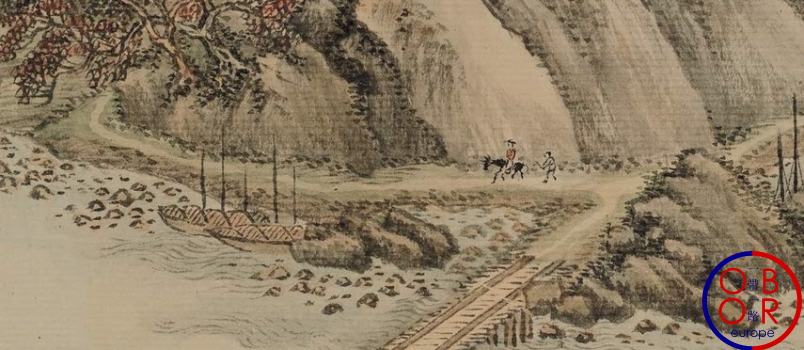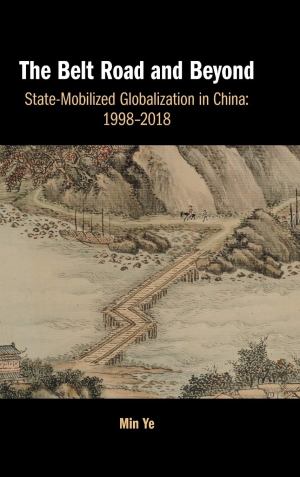Book review by Dr. Sebastien Goulard

In 2020, Prof. Min Ye (Boston University) published her latest book, “The Belt Road and Beyond: State-Mobilized Globalization in China: 1998-2018” (Cambridge University Press).
Since 2016, with rising global interest in the Belt and Road Initiative, there have been hundreds of books about China’s BRI strategy and implementation. But few have captured the essence of the BRI and many have only focused on the geopolitical dimensions and consequences of the BRI. For most authors, the BRI represents the rise of China and the BRI either poses a threat to international relations or creates opportunities for development abroad. Although authors have pointed out the overcapacity issues that might have driven China to launch the BRI, few of them have successfully analysed the origins of this strategy.
In her book, Prof. Ye traces the roots of the BRI back to two previous major development initiatives namely the Western Development Program (WDP) (1999) and the “China Goes Global” plan (CGC) (2000). The three strategies: BRI, WDP and CGC are all very ambitious but also relatively ambiguous with each containing no detailed guidelines. They were implemented in the aftermath of a number of crises (the 1997 Asian financial crisis, the Financial crisis of 2007, the 2008 Sichuan earthquake) as possible remedies to sustain domestic economic growth. As a result the BRI has not appeared out of the blue; however, like its predecessors, it is entirely possible for the BRI to be interpreted differently by local governments and companies.
This book studies the relations between the actors of national strategies and economic development in China. Prof Ye analyses the Belt and Road initiative by using the state-mobilized globalization (SMG) theory and the relationship between capitalism and globalization in China’s governance. According to the author, China’s system is different from liberal markets, developmental states, coordinated markets and state capitalism. The economic reforms conducted since 1978 have given China a unique system combining both a strong state and a strong market.
Summary and key points
The starting point of Prof. Min Ye’s analysis is that China’s governance is deeply fragmented among three blocks: 1) the senior national leaders, 2) the state agencies, and 3) the State Owned Companies (SOEs), private companies and local governments. According to Min Ye, senior leaders are implementing development strategies for social cohesion and nationalism, whilst local governments are motivated by economic growth. SOEs and private companies search for commercial opportunities. The author develops the SMG theory in the second chapter. By looking at interactions among the economic actors over a relatively long period of time (from 1998 to 2018), Min Ye shows that there is some coordination despite fragmentation.
The three subsequent chapters focus on the two development Programs and the BRI. Chapter 3 considers the implementation of the Western Development program, a national strategy initiated in 1999 to reduce territorial inequalities between Eastern and Western China. According to the author, the central government only gave directives, with no explicit targets, but managed to coordinate the interests of various economic actors to industrialize Western China.

Chapter Four examines the China Goes Global (CGG) development strategy and plan implemented in 2000 before China joined the World Trade Organization. This strategy aimed at increasing China’s outbound investment as the then President, Jiang Zhemin, argued that the imbalance between inbound and outbound Foreign Direct Investment was not beneficial to China. In the 1990s, local Chinese companies could barely compete with international firms that opened new branches in China. With the GGC, Chinese Companies were encouraged to invest overseas to become multinational. But Ye notes that market conditions were more influential than top down mobilization in spurring Chinese companies to invest abroad.
The BRI is studied in detail in chapter 5 where its origins, and China’s diplomatic motives to launch the program are discussed. Min Ye argues that the BRI follows the “infrastructure diplomacy” initiated by China in the 2000s but is better coordinated. An important point being that the BRI has succeeded in mobilizing every economic actor in China. However, the actual governance of the BRI is still rather complex, so local administrations and companies can also develop their own implementation plans for the BRI, each according to their own interests.
According to Prof. Ye, Chinese BRI stakeholders will continue to ascribe a strong business orientation to the BRI; she cautions readers that foreign countries may have “unrealistic expectations of China’s lending”, as they tend to recognize only the geopolitical and diplomatic dimensions of the BRI.
The final part of the book looks at the subnational (domestic) actors involved both in the BRI and previous development strategies. In Chapter 6, Prof. Min Ye analyses how China’s development policies were implemented in three different cities (Chongqing, Ningbo and Wenzhou). She argues that because those three cities enjoy different social-economic conditions, their interpretation of nationalist strategies were not identical. She writes “a city has considerable autonomy in choosing what central directives to follow and what directives are to be ignored”.
Chinese cities are actually using national strategies to advance their own interests and objectives. In Chongqing, authorities mainly used these strategies to revitalize state-owned enterprises, whereas in Ningbo, the priority was to upgrade the local industry. In Wenzhou, a city that enjoys less autonomy, due to its (prefectural) status, and is therefore unable to compete with the first two cities, local companies were more focused on short-term business interests. For Ye, the three cities’ main concern was local economic growth, not national strategies.
Prof. Min Ye, then, examines the response to the national strategies formulated by three Chinese companies: an SOE and two private companies. She does not believe that Chinese SOEs have fully embraced national strategies. She argues that the State and SOEs (state capital) are closely entwined, but that SOEs can still pursue their own commercial interests. According to her findings, private companies, similarly to cities, are also using national strategies for their own interests. The very ambiguity of those strategies allows for a broad interpretation driven by market conditions. Companies have also helped the State to conduct some national strategies (especially the WDP), so for Ye the state and market have reinforced each other thanks to national strategies.
In her concluding chapter, Prof. Ye argues that China’s SMG framework is unprecedented due to the size of the Chinese market and the degree of globalization in China. This system has enabled the development of national strategies including the Belt and Road Initiative within China.
Ye seems more wary of the success of the BRI abroad. In foreign countries, China cannot rely on the same “fragmented blocks” to implement its strategies. Moreover, the ambiguity of the BRI can be an obstacle for foreign parties to get involved in China-supported projects.
A book to better understand the BRI
Prof. Min Ye’s book offers a different perspective of the BRI. In this well-constructed book Min Ye shares with us the methodology she has adopted and the obstacles she also has met in some cities.
“The Belt Road and Beyond: State-Mobilized Globalization in China: 1998-2018” prioritizes academics and students who are eager to study the mechanism of development strategies in China.
The publication can also be read by reporters and entrepreneurs who want to better understand the Belt and Road Initiative. The BRI has been widely covered by Western media outlets, but most of the time, they fail to present the domestic impact of the BRI upon China. The fragmentation of the Chinese economy is a major point highlighted by the author, and this can (partly) explain the delays or evolution of BRI projects. It also shows that BRI projects are open to foreign companies as long as Chinese companies see some (commercial) interest in cooperation.
Another key point addressed is that China is used to working on long term strategies. The BRI has inherited some traits from the WDP and CGG, that were themselves created to fix issues caused by the economic reforming policies adopted since the 1980’s. Yes, the BRI is ambiguous, but this ambiguity gives enough freedom to innovate for economic actors including local governments.
“The Belt Road and Beyond: State-Mobilized Globalization in China: 1998-2018” can be purchased here.
